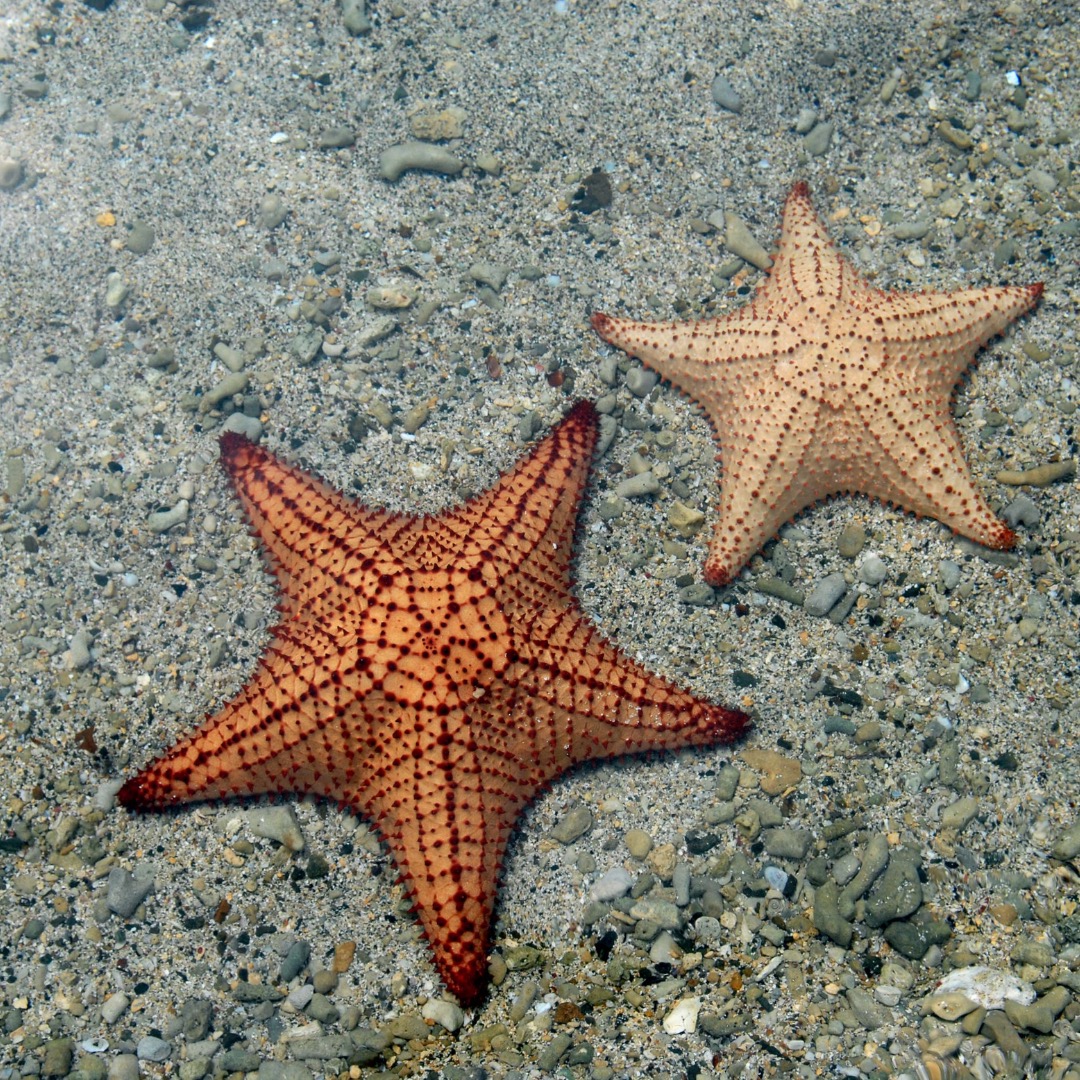Sea Star
Por um escritor misterioso
Last updated 22 dezembro 2024

You probably know sea stars as starfish, the name sea stars are commonly known by. But sea stars aren’t really fish. Sea stars, like sea urchins and sand dollars, do not have backbones, which makes them part of a group called invertebrates. Fish have backbones, which makes them vertebrates. Got it? Most sea stars sport spiny skin and five arms, although some can grow as many as 50 arms. The arms are covered with pincerlike organs and suckers that allow the animal to slowly creep along the ocean floor. Light-sensitive eyespots on the tips of the arms help the sea star find food. Favorites on the menu include mollusks such as clams, oysters, and snails. The sea star eats by attaching to prey and extending its stomach out through its mouth. Enzymes from the sea star’s stomach digest the prey. The digested material enters the sea star’s stomach. Tiny organisms can be swallowed whole. Sea stars occupy every type of habitat, including tidal pools, rocky shores, sea grass, kelp beds, and coral reefs. Some sea stars even live in sands as deep as 20,530 feet (9,000 meters). Sea stars aren’t social creatures, but they will congregate in large groups during certain times of the year to feed.

Scientists are breeding sea stars to fight climate change

Pink Sea Star - Georgia Aquarium

Canadian Register of Marine Species - Photogallery

That Which We Call A 'Starfish

Sea Star fun facts

Sea Star

Wild Side: Ochre sea star, Coastal Life

Sea Stars - NWF

Red Cushion Sea Star (Oreaster reticulatus) - ANGARI Foundation

Northern Sea Star (Asterias vulgaris)

Sunflower Sea Star Proposed for Endangered Species Act Protection
Recomendado para você
-
 Sailing (In The Sea Of Stars)22 dezembro 2024
Sailing (In The Sea Of Stars)22 dezembro 2024 -
 Sea of Stars - Official Palia Wiki22 dezembro 2024
Sea of Stars - Official Palia Wiki22 dezembro 2024 -
 Astral Sea - Verdict Wiki22 dezembro 2024
Astral Sea - Verdict Wiki22 dezembro 2024 -
 Chiaki Morisawa/Gallery, The English Ensemble Stars Wiki22 dezembro 2024
Chiaki Morisawa/Gallery, The English Ensemble Stars Wiki22 dezembro 2024 -
Crinoid - Wikipedia22 dezembro 2024
-
 3 Ways to Find the North Star - wikiHow22 dezembro 2024
3 Ways to Find the North Star - wikiHow22 dezembro 2024 -
 Wonder Of The Seas Itinerary, Current Position, Ship Review22 dezembro 2024
Wonder Of The Seas Itinerary, Current Position, Ship Review22 dezembro 2024 -
 starfish summary22 dezembro 2024
starfish summary22 dezembro 2024 -
 Sea Of Stars review: a slick RPG that harks back to the Chrono Trigger classics22 dezembro 2024
Sea Of Stars review: a slick RPG that harks back to the Chrono Trigger classics22 dezembro 2024 -
 STAR OCEAN First Departure R Character Profiles For Phia, Ashlay, Ioshua, Erys, Mavelle, Pericci, T'Nique – NintendoSoup22 dezembro 2024
STAR OCEAN First Departure R Character Profiles For Phia, Ashlay, Ioshua, Erys, Mavelle, Pericci, T'Nique – NintendoSoup22 dezembro 2024
você pode gostar
-
 desatado padronizar com cabeleireiro ferramentas. rabisco estilo22 dezembro 2024
desatado padronizar com cabeleireiro ferramentas. rabisco estilo22 dezembro 2024 -
 Gotham Knights on X: Get your systems ready! Recommended settings to come soon. #GothamKnights / X22 dezembro 2024
Gotham Knights on X: Get your systems ready! Recommended settings to come soon. #GothamKnights / X22 dezembro 2024 -
como jogar o jogo do foguinho e da agua|Pesquisa do TikTok22 dezembro 2024
-
 Kiwi's Adventure - Free Addicting Game22 dezembro 2024
Kiwi's Adventure - Free Addicting Game22 dezembro 2024 -
 Tensei Shitara Ken Deshita「Reincarnated As A Sword AMV」Somewhere22 dezembro 2024
Tensei Shitara Ken Deshita「Reincarnated As A Sword AMV」Somewhere22 dezembro 2024 -
 Toei Announces New 'Dragon Ball Daima' Series, Teases 'One Piece' 25th Anniversary Plans22 dezembro 2024
Toei Announces New 'Dragon Ball Daima' Series, Teases 'One Piece' 25th Anniversary Plans22 dezembro 2024 -
 League of Legends champion mastery scores for İLLAOİ BABA (TR)22 dezembro 2024
League of Legends champion mastery scores for İLLAOİ BABA (TR)22 dezembro 2024 -
 Unbound (The Wild Ride) - Avenged Sevenfold (song), YDG Music Wikia22 dezembro 2024
Unbound (The Wild Ride) - Avenged Sevenfold (song), YDG Music Wikia22 dezembro 2024 -
![Melhores programas e jogos para Windows: 11/02/2014 [vídeo] - TecMundo](https://i.ytimg.com/vi/mLiCxtvHzWQ/maxresdefault.jpg) Melhores programas e jogos para Windows: 11/02/2014 [vídeo] - TecMundo22 dezembro 2024
Melhores programas e jogos para Windows: 11/02/2014 [vídeo] - TecMundo22 dezembro 2024 -
 Sly Cooper 20th anniversary art print22 dezembro 2024
Sly Cooper 20th anniversary art print22 dezembro 2024
